







 |
 |
 |
 |
 |
 |
 |
 |


 FF357
358
369 373
375
376 390 396
403
406
reborn
return
A-1998 3:8
3:47
3:60
family
500
536
550
558
566
570
FF357
358
369 373
375
376 390 396
403
406
reborn
return
A-1998 3:8
3:47
3:60
family
500
536
550
558
566
570

Summary: from DeFalco to Millar
The period up to 1991 saw the
Franklinverse take over from the Marvel Universe, replacing a
stretching timescale with a chaotic sliding one. Now in part 2 we
see the Franklinverse slide toward chaos (the Great Reboot of
2010-2025, also known as the Chaos War), and how Franklin looks to
Doom for help. This period begins with the second the run often
considered the second worst in FF history, and ends with the one
that beat it to the top spot. Not everyone feels that way of
course.
DeFalco's run on the Fantastic Four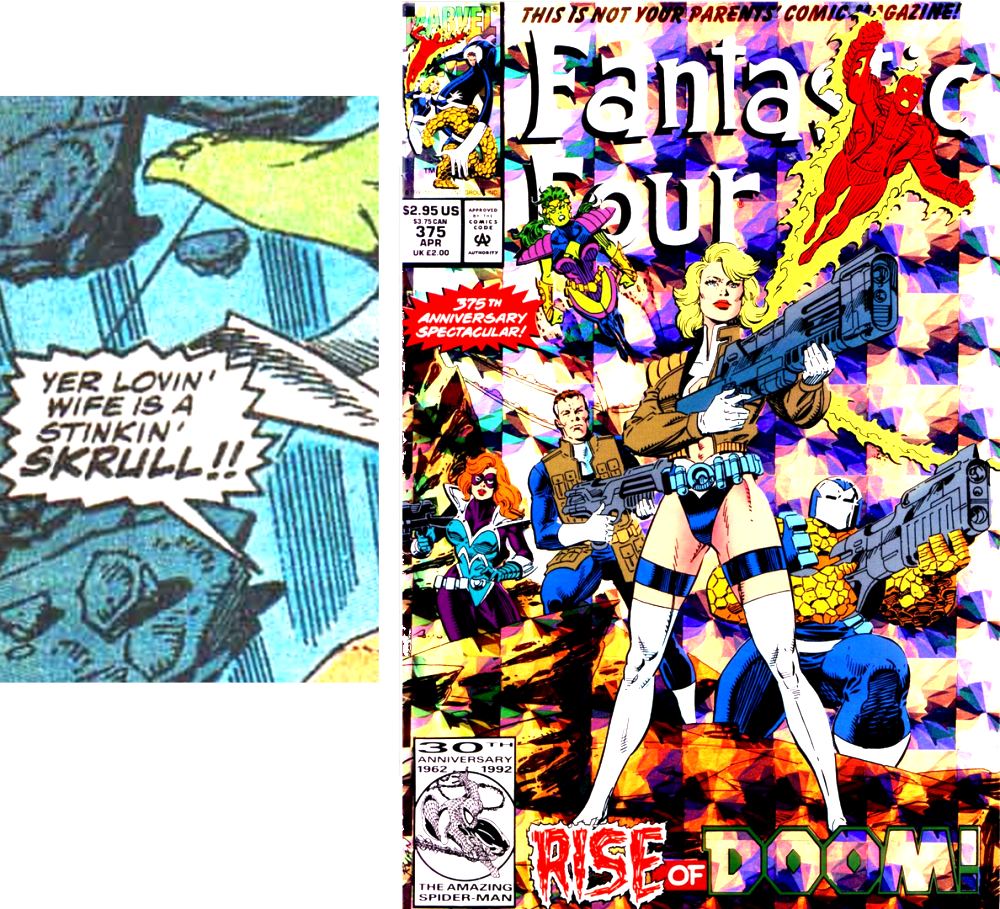
In "Comic Creators on the Fantastic Four", DeFalco recalls that long time fans called him "The Evil One." Why so much hate? This is what long time fans said (on the FF message board): Personally I would say no there are no good
issues as I've read his entire run.
It was just so so bad...but at least the art was pretty. DeFalco should never be praised for his Fantastic Four
run. DeFalco's run typifies Marvel at it's absolute
worst. Bad storytelling. Stringing readers along with
dangling plot lines, Special covers, Killing of cast
members to boost sales, angst. Marvel had
it's problems at the time but I would say DeFalco's work
on the FF was way worse than the Crossing and the clone
saga...those disasters just got more attention.
I'd also add very bland, unforgettable attempts at new
villains like the lame Occulus and one of the weirdest
Doom stories ever with Vic selling drugs to Yancy
Streeters. I also got the impression that DeFalco just
didn't like Reed as a character and killed him to get
rid of him.
One good thing DeFalco does is reply to fans. I wrote
him after he got the Legion gig and he wrote back a very
nice letter, which he did to most fans of that book. |
On the plus side, a lot of people did enjoy DeFalco's run: mainly
new readers who did not know how the fun stories were either
copying old ideas or damaging long term continuity, and without
the experience to know that if they could not make sense of Nathan
it was not actually their fault. And compared to other comics at
the time, DeFalco's (with Ryan's art) were a breath of fresh air
for new readers. Other titles were often impenetrable.
besides, that, everyone agrees that DeFalco is a really nice guy,
good with fans and fellow workers alike, and most people agree
that Paul Ryan's art was good.
So what went wrong?
After seeing what happened to Englehart and Simonson it will come
as no surprise that DeFalco was operating under horrendous
conditions. But worse than that, he was Editor in Chief at a truly
horrible time. He had to deal with impossible demands from above
and the resulting chaos from below. Read "Marvel Comics: The
Untold Story" for what it was like. DeFalco comes across as quite
the hero, defending the workers from the owners from Hell. DeFalco
had an impossible task and can be forgiven for not giving the
Fantastic Four the attention it deserved.
Take for example the hated "Lyja's baby" story. Paul Ryan (the artist) explains:
"One problem I faced were late plots. I tried for nearly five
years to get that book ahead of schedule, turning down other
assignments, to no avail. Tom was just too busy with other
projects, not to mention his duties as Editor-in-Chief.
Another was changing plots. A story we discussed and which
I found very exciting was frequently changed when it reached
printed plot stage. I think Tom spent too much time
second-guessing himself. Lyja and Johnny were supposed to
actually have a child. I was shocked and disappointed when Tom
changed the child into an artificial implant housing a monster."
(source)
The pressures and chaos continued to the very last issue of
DeFalco's run. Ryan again:
"The whole Heroes Reborn situation [how the title was rebooted
after FF416] came as an unpleasant surprise to me. I learned
through the Internet that I was losing the FF. Tom and I were
supposed to work together through issue 416. Yes, we were told
to complete our story arc as quickly as possible. The
powers-that-be (executive level management) came up with the
idea of luring Jim Lee back to Marvel in the hopes of recouping
lost sales figures. Jim wanted the FF. Marvel gave it to him
over the head of Editorial. Editorial decided to show that they
also could do an Image style book without Jim Lee. Therefore I
was unceremoniously removed from issues 415 and 416 and they
were given to Carlos Pacheco. This whole situation left a bad
feeling with me toward Marvel. I was cast adrift after 11 years
of loyal exclusivity. I have not followed any of the Marvel
titles since then, so I cannot comment on their merits." (source)
The chaos of the 1990s is legendary. Not even DeFalco's Editor in
Chief job was safe. This was a recent question to Tom Brevoort on
his blog:
"Q I read that during the 90s there was a period in which
there were 5 group editors-in-chief of different lines instead
of one common editor-in-chief. Since you were around at the
time, do you know why they decided to do that and why you think
it failed?"
"A That was done to weaken the authority of any single
Editor in Chief and give the Sales Department the upper hand,
and it failed because it was a moronic idea in the first place."
- Brevoort.
On the bright side...
All of this fits perfectly into the bigger picture of the Fantastic Four as metaphor for the Cold War. When the cold war ended the book lost its direction.
Given that the chaos makes sense on the larger scale, the rest of
this page tries to make a silk purse out of a sow's ear: let's
tease out what "was really happening."
The first event post Simonson was to get rid of the Alicia
marriage. We are told that Johnny in fact married a Skrull called
Lyja, disguised as Alicia. However, that contradicts the previous
story: it breaks the flow of the 28 year story, it strains
credibility that Reed had no Skrull detectors in the Baxter
Building, and Lyja contradicted Alicia, for example over whether
she was able to create representative sculpture (see the discussion of the different FF)
So what is really happening?
We saw that Franklin reversed stuff and injected new memories in
the dimension hopping of FF326, FF332 and perhaps FF541 or
thereabouts. Alicia's actions triggered Act 5, so Franklin had to
particularly reverse her influence. So it appears that Alicia and
Lyja were switched at one of these later points (i.e. after FF321)
and given new memories. The generally confused state of affairs
explains why the Skrulls were so easy to defeat in FF258.
Note the method, how Franklin changes things: he simply shunts people into the nearest reality that has the desired features. There may be highly complex reasons behind why the new reality is different, but Franklin is not be involved at that complex level.
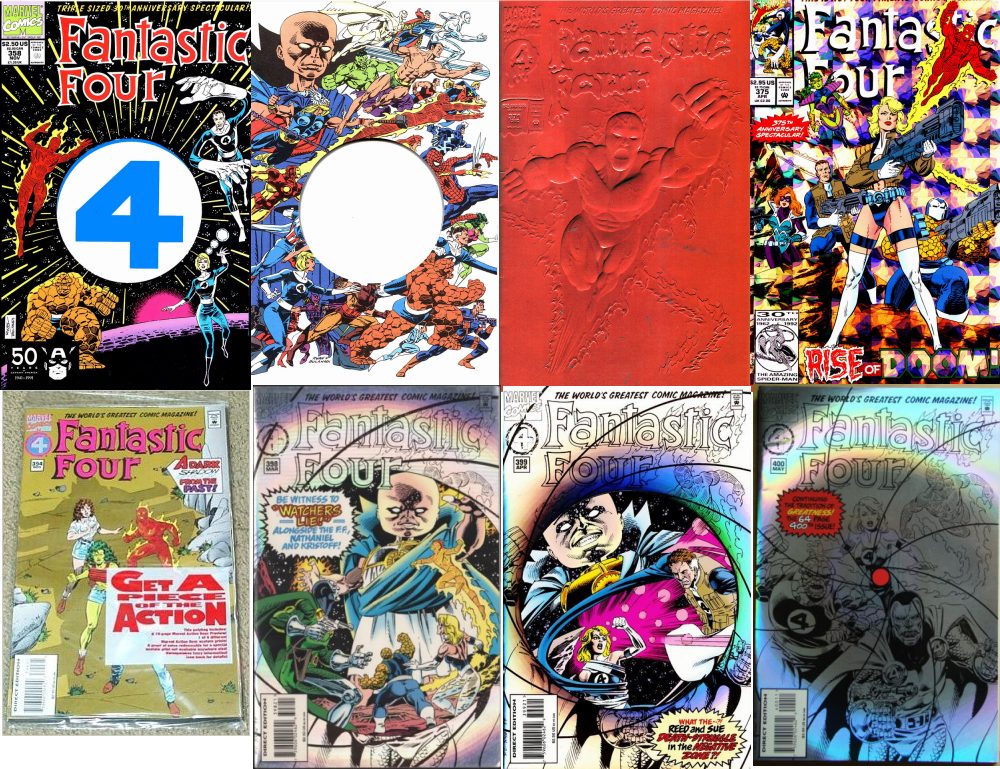
The page on differences notes the
contrast between the original team and the clone team we began
following at the end of FF 333. In this and the following issues we see
those differences very clearly. The new Sue does something the original
Sue would never do: she voluntarily merges with Malice. She also forgets
that she can make things invisible. The new Ben, unlike the old Ben in
act 5, is plunged into despair again. He says he does not love Alicia,
in stark contrast to the original Ben in FF 301.
In this period the only consistent theme is Franklin. And the
only consistent part of Franklin's plan is Victor Von Doom. Why do
Franklin's plans generally center on Doom? Because deep down,
Franklin wants two things: safety, and his father's
attention. Both needs are frustrated by one man above
all: Victor Von Doom. So Doom has to be neutralized. All of
this is of course unconscious. Or rather, it's organized by
another version of Franklin: as we saw in FF annual 23, young
Franklin is often unaware of what his other avatars are doing.
It may be helpful to see an outline of Doom's activity in this
period. Note that before this period Doom's quest reached its natural
conclusion in act 5, but then Franklin
panicked and upset everything.
The key to understand Doom is to see him as an extreme version of
Reed. He has Reed's arrogance multiplied, but he also shows how
Reed should put his family first. Doom at his best cares deeply
for his people. He is at his strongest with his people behind him.
Indeed, the name "doom" comes
from the word for "home" - the same root as "domos" or
"domestic." We see Doom as the ultimate selfish individual, but he
is also the ultimate family man. All his motivation comes from his
early family ties, his love for his parents, and his desire to
create a better world where nobody will ever suffer again. Doom
more than anybody understands how we can rule through others:
through his son, through Kristoff, or ultimately through Valeria.
Doom's lowest point was when he neglected Latveria in the early
1970s, and his greatest defeat was when he opposed his son in
FF200. In the Franklinverse period we see him "adopt" a daughter
(Valeria) and she will be his salvation.
Here's a summary of Doom's actions from the
start of the Franklinverse to The
Great Reboot.
1989
The original plan was to keep Doom busy with an equal and opposite
Doom. This was the climax to the original 28 year story: Byrne's
plan for a year of Doom Wars, and Englehart's climax in FF annual
20.
1991
The retirement plan didn't work. Franklin was to scared to let
Reed explore his powers, so Reed had nowhere to go... and returned
to the team. A new, different
Doom then appeared and defeated the Kristoff Doom. Why? We
can piece together the clues. new Doom said he's been away for a
very long time, and had a new costume. But that costume was only
very recently obtained in Otherplace (according to one of the
Captain Britain titles). Otherplace is the closest thing we have
to a representation of Franklin's internal world, and here time
breaks down so it's quite possible that this Doom believed he had
been away for a very long time. Why would Franklin unconsciously
create a stronger Doom? The next few years give us the answer.
1997
Franklin's new strategy seems to be to focus on Doom's nobility.
We saw in the original 28 year story that Doom is at his best when
caring for his people. Franklin arranges the universe so that Doom
has a whole world to care for (the Heroes reborn world).
2000-2002
Here we see the secret to Franklin's plan: Doom has always cared
for his family, so the obvious solution is to make the Fantastic
Four part of his family. Franklin does this by making Valeria his
child: at first literally, then symbolically. (This period as
usual involves shunting between different times and realities.)
2003: hell
It all goes horribly wrong. The particular alternate reality Doom
used here turns out to be particularly vicious. So the next
attempt will begin by checking out all the other alternate reality
Dooms.
2005: Reed rules Latveria
Franklin's efforts to unite Reed and Doom continue as Reed takes
over Latveria, but of course it doesn't end well.
2006: Doom tries to lift Thor's
hammer
Franklin's belief in Doom's basic goodness must be strong:
the Doom that returns from Hell does not want the super-evil human
skin costume, and even tries to life lift Thor's hammer, but of
course he isn't worthy (FF537). This is after Doom and Reed to
battle it out in Manhattan (FF535). Franklin no doubt wants them
to come to some conclusion, but they never do.
2007: Doom warns of a future
Reed
In FF551-3 we see where Reed's desire to fix everything leads - to
a future where he controls everything, just like Doom. By the end
of the arc we are assured this is a Good Thing, but Hickman's
later Council of Reeds story suggests otherwise. The story ends
with Doom being sent off to rule an entire world - suggesting that
his rule really is benign. The bottom line is that Reed and Doom
are so similar that Franklin's unconscious instinct is correct:
solving one problem means solving the other.
2009: Doom's rehabilitation
continues
In the "Master of Doom" arc Doom appears like an angel compared
with his old boss. But these are both alternate reality versions
(the real Doom would never kneel before another) indicating that
the dimensions that Franklin was supposed to guard are falling
apart and being consumed.
2009-2011
The key to this long story is "All hope lies in Doom." Older
Franklin is part of a plan in which the new, nobler Doom will
merge with Reed Richards. Valeria is central to the plan of
course. Doom is brought on the side of the team in the final great
push that marks the start of the Chaos War.
A future version of this page will examine the parallels between
the Chaos War and Jonathan Hickman's run.
Marvel's major crossover events may be a guide to Franklin's unconscious fears and actions.
Franklin seems to respond to pressure by creating or accessing parallel worlds and parallel beings, but these usually end up even worse than before.1990-91 saw "The X-Tinction Agenda" and the Infinity Gauntlet: increasing danger to the world, and especially mutants like Franklin. This led to parallel versions of the heroes (in the 1992 Infinity War) and a parallel version of Earth with a demonic invasion (the 1993 Mys-Tech war). Note the presence of Death's Head.
Another feature of these crossovers is dystopian futures (e.g. Days of Future Present) and conflict between fathers and sons. In Age of Apocalypse (1995–1996) Legion kills his father, Charles Xavier, creating a dystopian alternative time line in which Apocalypse rules the world.
These cross overs reflect the real world of course. Marvel sought to maximize revenue by linking everything together ever more tightly: but some Marvel titles were a lot less realistic than others, and forcing them together on a regular basis ended any claim to believability.
All of this responsibility is too much for one mind.
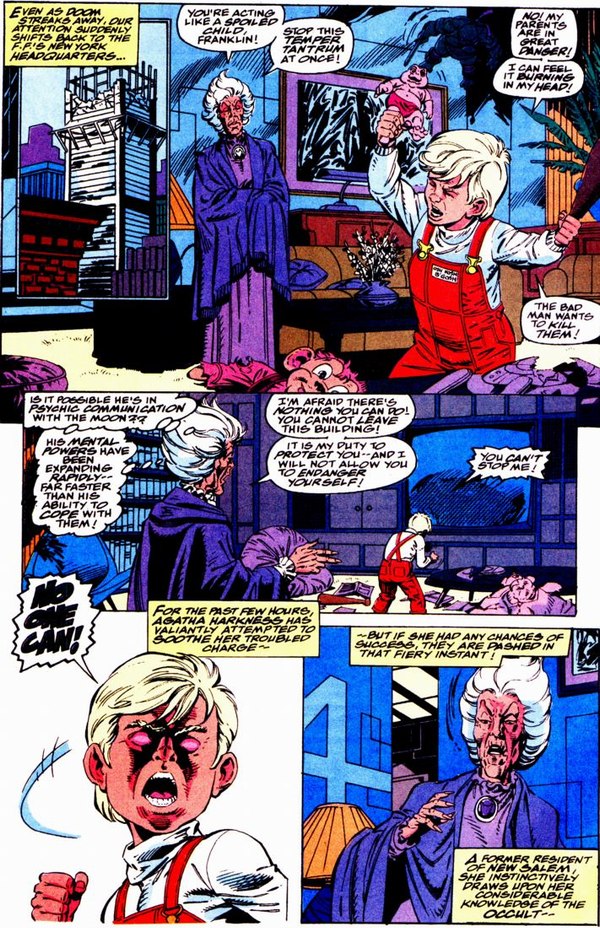
In his desperate state Franklin is about to destroy everything. For the universe to survive he has to be taken out of this crazy mess (and just read Marvel comics 1991-1994 to see what a crazy mess it had become).
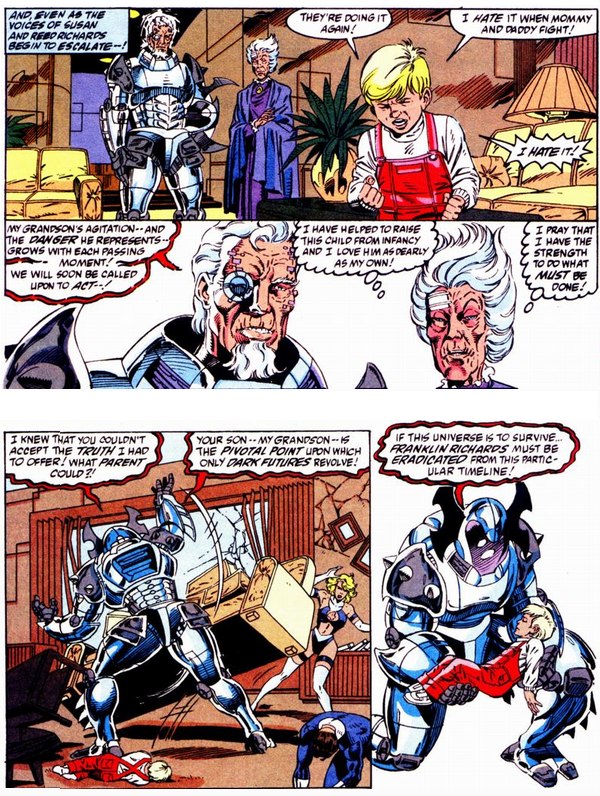
When he gets back we see he spent his time bouncing between the time streams, fighting alongside his grandfather.
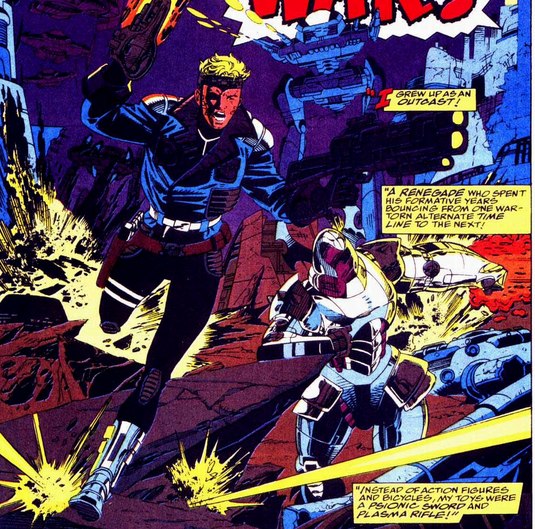
What was he doing? Trying to protect the time streams (and apparently failing). The key points are in FF390:
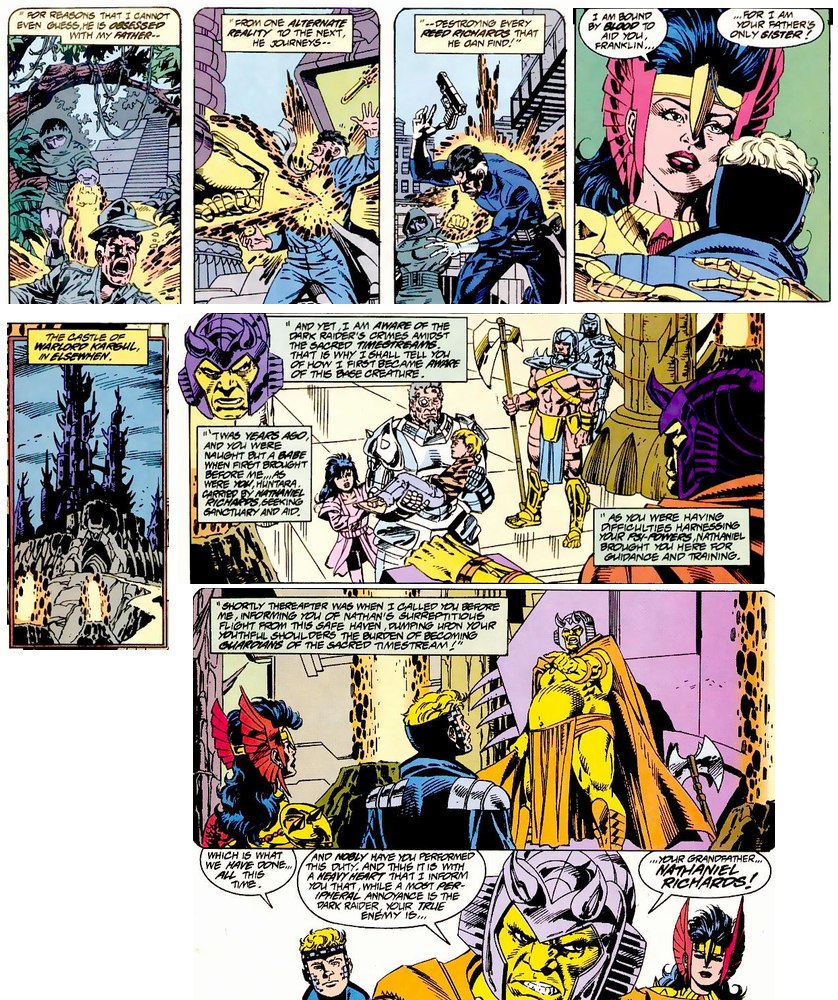
The key points are:
It may look like a confusing mess, but step back and it's really quite simple:
Everything stems from this conflict:
The universe reflects Franklin (1989-present)
This is the "pathetic fallacy," an old Shakespearean theme (and far older than Shakespeare: e.g. Arthurian legend and ancient kingship): the state of a nation, and even nature itself, reflects the quality of its ruler. We see this in the Fantastic Four and the wider Marvel Universe in this time. Franklin continually fails to protect his family, seeing alternate reality versions of his parents frequently killed (and sometimes a parallel world Franklin dies). Meanwhile Reed and Sue argue and the team falls apart. In other comics everything is dark and full of personal conflict, especially among mutants (Franklin is a mutant).
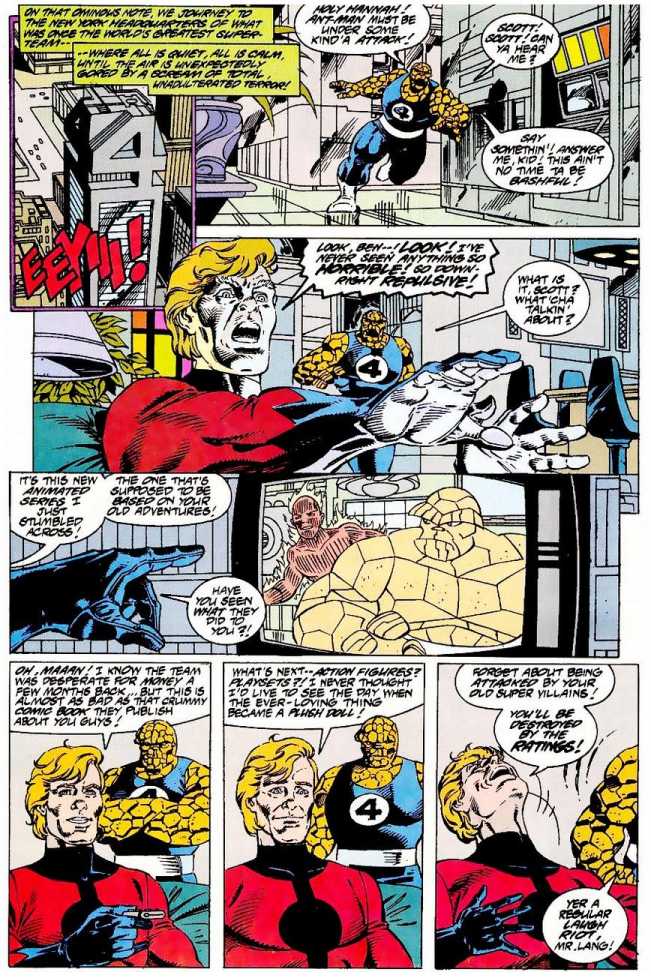
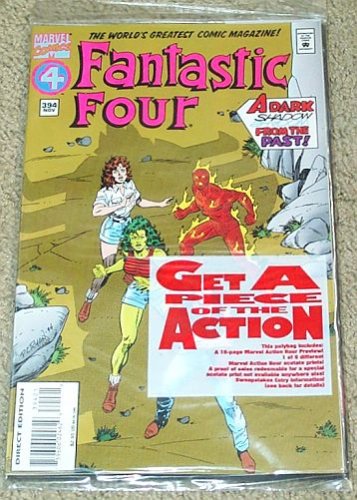
The "Fantastic Force" comic records Franklin's attempt, and failure, to be a successful teenage superhero. At one point we see multiple versions of himself, a point confirmed in the main comic (FF403). Franklin is unable to keep everything together. He's desperate, miserable, his powers are going haywire, something is going to break..
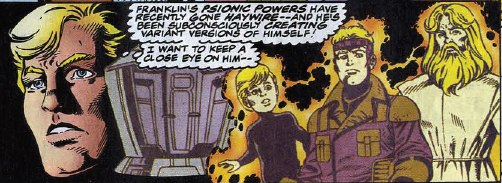
The chaos reaches a peak: Franklin unconsciously unleashes everything he's got. He creates a son who is a living conduit to hyperspace, just as Franklin is a living conduit to the negative zone (see annual 1998). The two powers are pretty closely related actually.

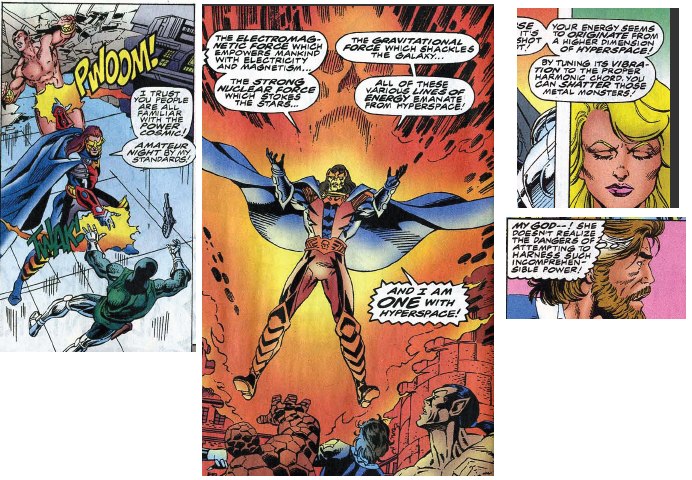
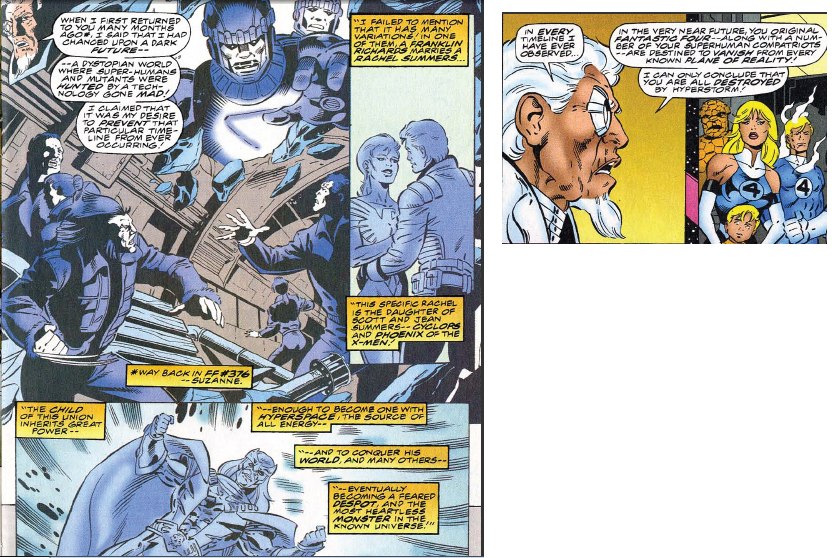
Unable to cope with reality, in FF413 Franklin de-ages again in order to hide from reality. He cannot cope, he cannot consciously facing the chaos he has unleashed.
Onslaught
Do not be confused by the apparently different nature of
Hyperstorm and Onslaught. Step back and you will see it all as
manifestations of the Franklin's power. The pressure in Franklin's
head is so great that if you stop one unlimited danger
(Hyperstorm) then another is there to replace it (Onslaught). As
for how Xavier and Magneto relate to Franklin, that would require
several more pages! But basically it all comes down to Phoenix.
Heroes Reborn is the clearest and best known example of Franklin controlling everything.
Franklin creates a pocket universe where all Marvel comic stories live, with him pulling the strings. The same year sees two of the more interesting fractured universes: the 2099 dystopia (featuring the team from 1996) and Amalgam's "Challengers of the Fantastic." Franklin is trying everything and seeing what sticks.
When the Heroes Reborn experiment fails and the teams return to our reality, we once again see signs of a merge with Limbo. Compare the demonic effects of "The Ruined" with the merging with Limbo in FF322.
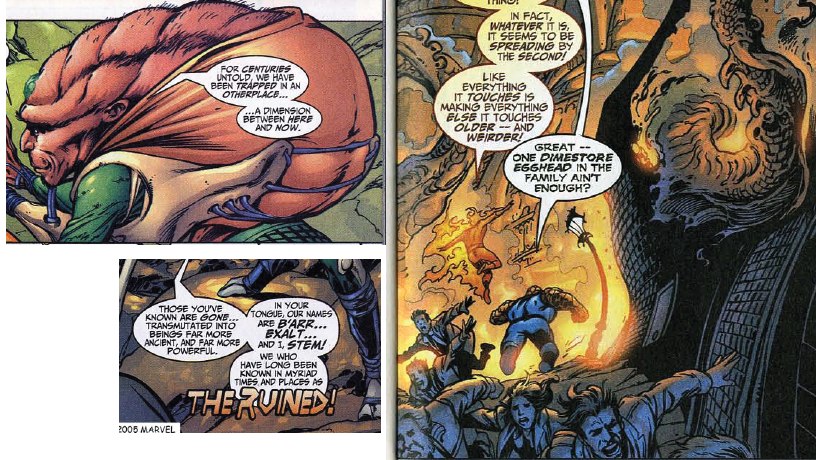
The end of Heroes Reborn (called Heroes Return) finally clarifies why superheroes exist and why Franklin matters. Ashema, a Celestial, explains to Franklin:
"We conduct experiments, too. And one of them was on this world as life developed. But we have accomplished all we have set out to do. To make you, Franklin. Or someone like you."
For details, see the page on the origin,
on the cosmic, and the commentary to
FF319. The Celestial then continues
"And now it is time to wipe off the petri dish."
This can be seen as another test: Franklin and co. should be able to pass that test, and they do. Later she says:
"This is how we knew that humanity had reached its pinnacle in you. You have created Life. You produced something from nothing"
But creating life is never simple, as Franklin discovers. The
whole point of life is that you don't control it.
Franklin must come first. Sue understands but Reed does not.
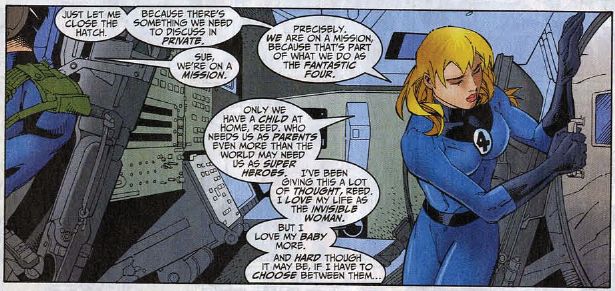
With continuity broken there was nothing to do except tell the same stories again and again in different ways. So the original universe fractured into many parallel universes: Ultimate FF, Heroes Reborn, Marvel Adventures, 1603, 2099, Zombies, Apes, Manga, Amalgam, etc., etc.
In the Franklinverse the main title routinely forgets its past:
all the themes of the first 28 years are forgotten, along with
most of the characterization. Any unpopular story is instantly
forgotten, such as Mark Millar's million year old Dr Doom fighting
a giant shark with his bare hands: nobody mentions that. With
continuity such a low priority the canonical status of different
titles is ambiguous. For example, is Marvel Knights in continuity
or not? Fans disagree.
Pier Four
To symbolize the chaos, change and division, the team briefly
move to a new location: Pier Four, on the Hudson River, just above
Stuyvesant High School. Later they return to a rebuilt Baxter
Building. For more about the Baxter Building see issue 3.
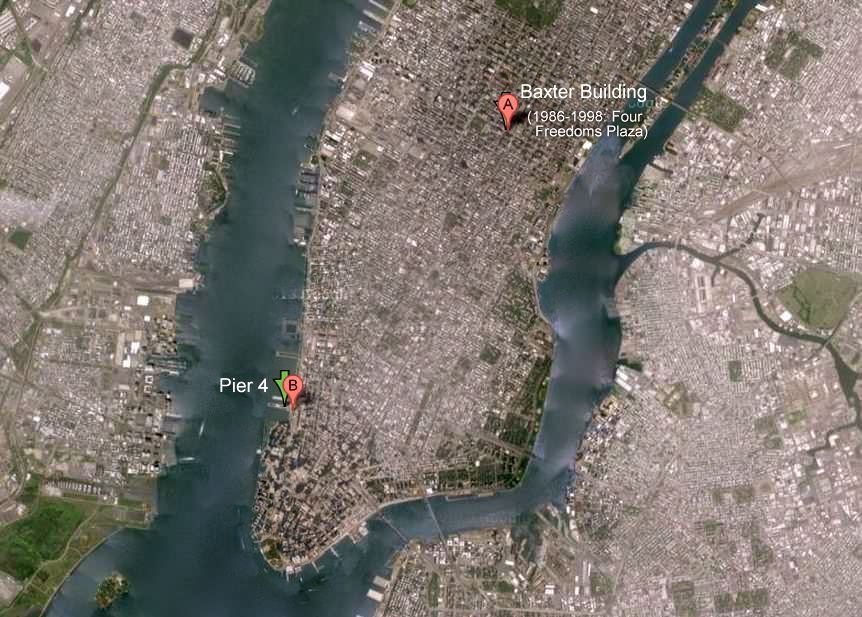
The Franklinverse is vaguely aware that they are not the original characters, or if they are then somebody is messing with their heads. In the 1998 Fantastic Four annual the post-continuity Ben visits an alternate reality: the Real Time FF. The story shows what would have happened if real time had continued as it did in the 1960s. Sure enough, Reed and Sue are in "retirement" but doing exciting things, and they're always ready to return when needed. And the team in led by Johnny, who's married to Crystal, and Franklin and Luna are part of the family.
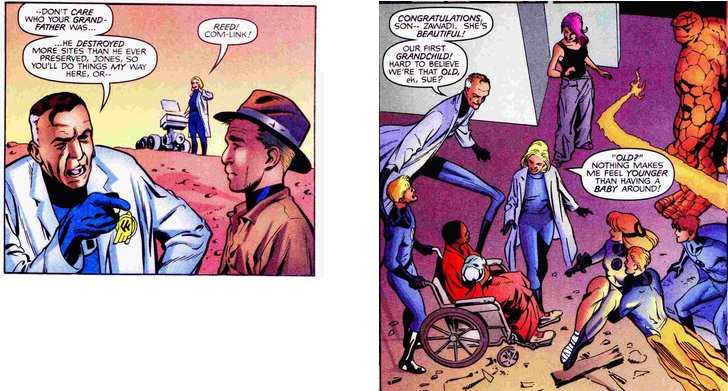
This isn't exactly the same as the new FF discussed on this page: the 1998 FF diverged from our continuity in 1973. In this version Ben never got over his insecurity, and as a result he never married Alicia. So Johnny never fully matured, and is still emotionally a teenager, but in most other ways this is a fair approximation to what the future would hold if Fantastic Four continuity had continued. It's also a fan favorite, based on comments on the comicboards forum. And when Tom Brevoort was asked which never reprinted comic was the best, his reply was "Dan Slott would say Fantastic Four Annual 1998."
Incidentally, Karl Kesel wrote the 1998 annual. He also wrote the
much loved issue where we see the Thing and his Jewish roots
(volume 3, 56). And he wrote the first five issues of Fantastic
Four 2099 until he and the rest of the team resigned on a point of
honor. If Marvel wants a good established comics writer to take on
the FF they could do a lot worse than Kesel. According
to all the interviews I've seen he would love the job. He's a
pretty good artist as well. (He's also a
fantastic human being, adopting a baby who was addicted to
heroin and selling his comics to pay the medical bills, but that's
a little off topic.)
Discussions on the FF message board indicate that long term fans
usually rate him their first choice as a new writer. But for some
reason The Powers That Be will only ever give him the occasional
issue (such as writing dialog for Matt Fraction's last four
issues) and then only use him as an inker. Nobody knows why.
For a couple of years Franklin sees to have been hopeful. Franklin seems almost happy, and for this brief period the original team seem to return.
Why the team returns
They original team seems to appear when Franklin powers the team
up in volume 3 issue 8. Why was Franklin suddenly hopeful? He gets
to save his family, and then gets himself a dimension jumping
friend (Puppy) and a dimension jumping (or "time dancing") sister,
Valeria. Note that Valeria's age (13) is very close to her real
time age (the apparent miscarriage was in 1984, and Valeria
appears in 1999).
Why the team disappears again
Franklin seems to have engineered a chaos storm (unconsciously).
It builds over many issues. It's the kind of event that can reboot
a universe, and only Franklin can save it. This is the perfect
opportunity for Reed to admit his limitations, focus on Franklin,
and have a great bonding moment where Franklin assumes his
rightful place in the team. But instead, once again, Reed fails
spectacularly. In issue 24 he sends Franklin away!!!!!!! The one
being who could have saved them!
The Chaos storm is caused by the dreaming Celestial seen in
Simonson's run: yes, this is seems to be part of that chaos war. It is
finally resolved by Reed and Doom working together. This was
presumably Franklin's plan all along: the friendlier Doom was how
Valeria appeared, but without Franklin being present the merging
of Reed and Doom fails. (As with the Kristoff method in
annual 20, this could have ended the Doom problem forever.) With
the strategy failed, and Franklin not present, the original team
cannot stay. We see multiple versions of the team in issue 34 and
it appears that the comic ends up following the wrong team again.
In issue 35 the Franklinverse team
are back.
Not everyone liked Chris Claremont's run
Claremont arrived almost by accident, so his first issues can be
forgiven for being a little rough:
"It’s clear that Claremont and Larocca’s arrival wasn’t
particularly planned – Lobdell had previously stated an
intention to stay on board the title for a 50-issue run, and his
plots were used for two issues following his departure.
Claremont, for his sins, had recently returned to Marvel to work
as an “editorial director”, and was presumably just in the right
place at the right time to take over at short notice when
relations between Marvel and Lobdell/Davis broke down, for
whatever reason." (Bronze Tiger, on the FF message board)
The main criticism of Claremont's run is it was too much like the X-men. As one fan wrote, "Alyssa Moy could be Psylocke, Caledonia from Excaliber, Valeria could be Rachel". People who do not like Excaliber generally do not like Claremont's run. But in his defense it was probably the best established way to make sense of the crazy parallel realities that sprang up since FF322, when Franklin went haywire. Excaliber specialize in such things.
Claremont is also blamed for reintroducing Valeria, which is
probably unfair. Most people quite like his teen Val, but the
later de-aged Val is so toxic that to some fans anybody connected
with the character is stained. For the record, the most hated part
of the character is her absurd intelligence,a creation of
Mark Millar (who else?): "Millar threw this wrinkle into the
book during his much loathed run and Hickman chose to nurture it
without analyzing the concept. It's ridiculous. Much like
million year old Doom battling mortality with the strength of
hate.. it's a poorly conceived and pathetic concept.. MM's short
attention spanned trademark." - Karl Disley
Another plus is that Claremont's books take more than five
minutes to read. Whatever else can be said, you get your money's
worth, and that's a rare thing these days.
Was the Sentry Franklin Richards? That would explain a lot. This would be a way for Franklin to gain the respect of his father, and thus get his attention, and so be let into the team as a full member as Reed promised but never delivered. But Reed doesn't seem to pick up on the clues that the sentry is Franklin, and the experiment fails, so Sentry finally gives up his desire to live.
Also in 2000, Apocalypse emerges once more, along with a mysterious prophecy of 12 powerful mutants capable of destroying him. One of them is of course Franklin.
The Franklinverse is based on zero changes, and so it cannot work (stories imply change: no change means no story). The Franklinverse periodically falls apart into continuity chaos: the different worlds merge, the major powers get involved (Galactus level and above). 2001 is a good example. Other examples were 1989-91, 1996, and the mother of all reboots, 2010-2025.
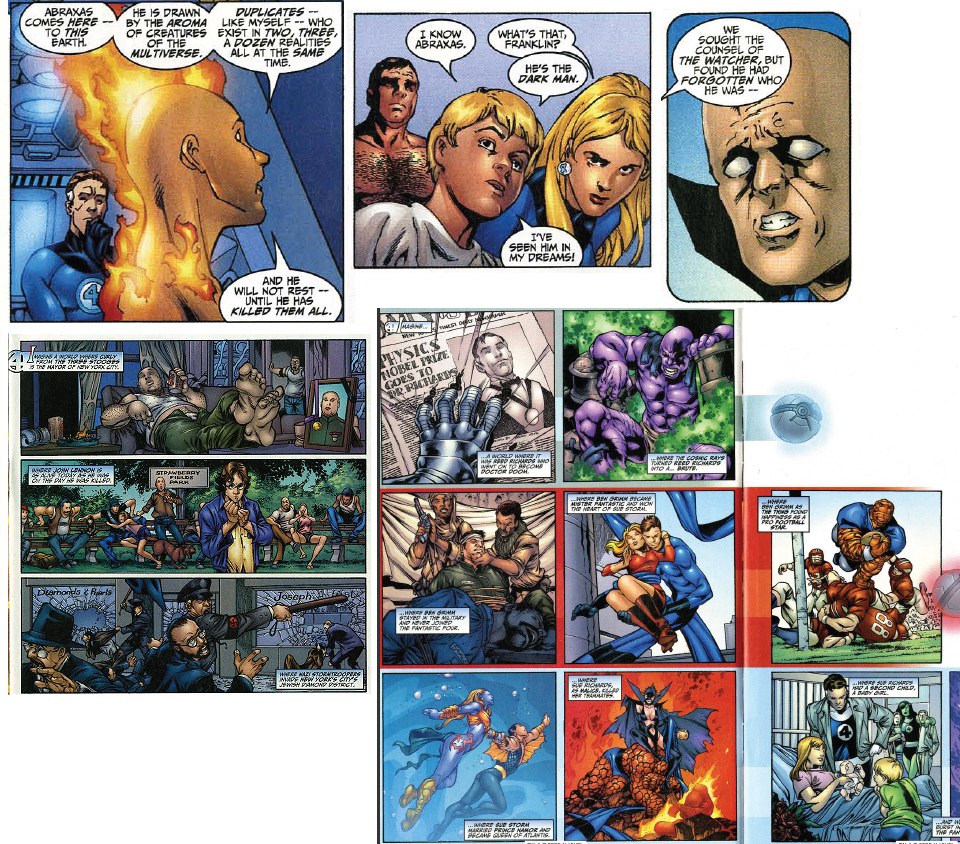
Unlike the DC comic reboots these are claimed to be the same people with the same history, so officially nothing has changed. But like in FF344 we must look closely to see the differences. Make no mistake, these are major events that reboot the entire Marvel Universe, and Franklin is the one who hits the reset button each time. In the 1991 reset we see Franklin's role very clearly, and even see Franklin inside his own "elsewhere" world.
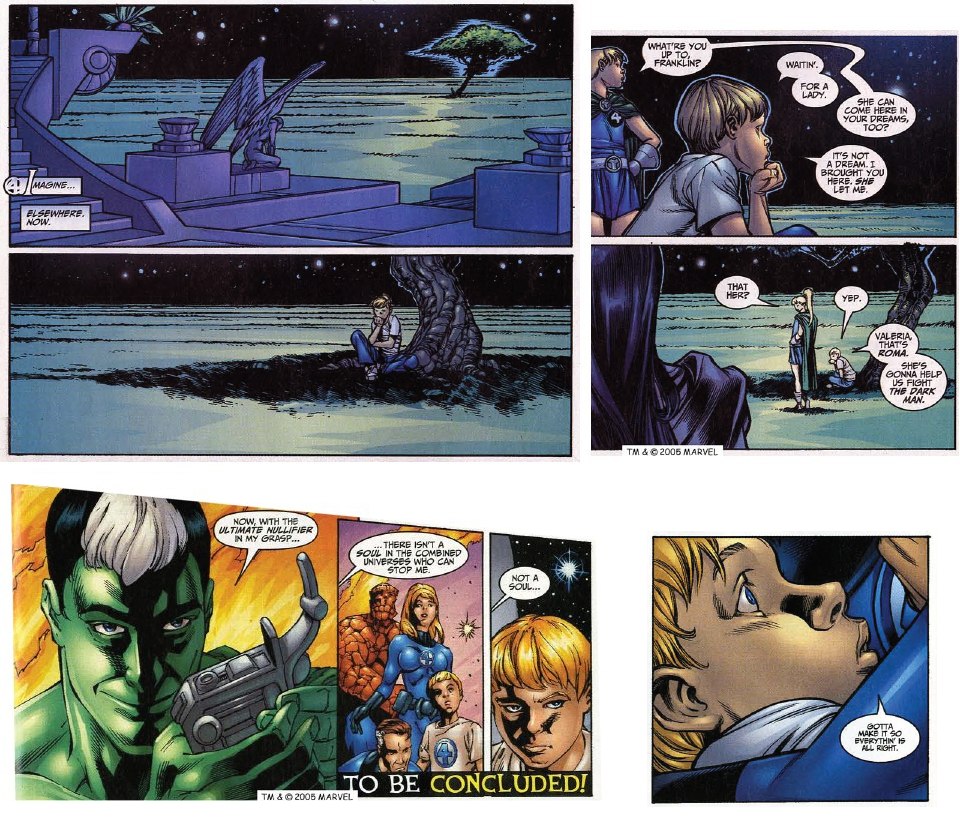
The Abraxas story ends with a reboot, and Valeria is born. Ah
yes, Valeria. On the surface this is just bad writing - take a
moving and well told story (how Sue lost a baby) and ruin it, then
make the baby the most irritating child ever. But look below the
surface: there is logic to this. All is not as it seems...
2002-2013: Valeria: what's that
all about?
|
Is the FF really about family?The Hell story was the centerpiece of Mark Waid's popular run on the title. This was when Franklin and Valeria began to look almost like normal kids in a normal family. So maybe it's time to talk about family. In recent years it has become normal to talk about the FF as being "about family." But that was not true in the 1960s and 1970s. In fact, you could argue the opposite: "It’s sometimes forgotten that the Fantastic Four, for example, often functioned not as a symbol of the family so much of that as the institution’s decline. Reed was often cast as the absent, disconnected company-man father, Sue Storm the bored, frustrated and romantically tempted housewife. Ben Grimm was the fractious, demanding intruder from the extended family, and Johnny Storm the rebellious, alienated youth who put his own ill-considered desires before the communities’ best interest. In its time, this was a fundamental break with how the family was portrayed in the super-book, although in truth the family had rarely been represented at all in the sub-genre." (source)And of course Sue and Johnny lived elsewhere and commuted in for the first four years, before the wedding. And after that the idea of the best friend and kid brother sharing the marital home is not the narrow definition of the nuclear family. This team is extremely close, sure, but does that mean it should be "about family?" The title sold far more copies back when it was about "incredible exploits and down to earth realism", the definition of success from FF9. "About family": a bad idea?Here are some comments from the FF board:
"About family": too difficult to do right?
"About family": destroys Ben Grimm as a character?
Solutions to the problem:Three families - the Clan Fantastic?At the height of the classic era (circa FF50-60), the
greatest stories were written around three separate
sub-teams: Johnny/Wyatt/Lockjaw, Reed/Sue/Ben, and the
Inhumans. A three sub team book could work again: Several sub teams also allows flexibility for one or more person to leave without really leaving. This solves the "OMG Reed and Sue cannot leave!" problem of FF307, and also provides the flexibility that keeps the X-Men and Avengers selling more copies than the FF. Marvel Editors? Is anybody listening? Kids running wild - an old style family?As for what to do about Frank and Val, here is my own
view. This is from the previous discussion, and fits best
into a "Clan Fantastic" model.
|

The Valeria and Doom arc leads to Franklin being in Hell. But we have seen before (in Byrne's run, or annual 20) that Mephisto is scared of Franklin: how could any version of Hell keep him?
Clearly Franklin at this point is miserable so is in his own private
hell: when rescued he still saw himself as there.
At this point Reed is routinely keeping secrets,which prevents
Sue from moderating his crazier ideas. Saving Ben from heaven
would have given Reed's inflated ego one push too far. It is also
possible that the machine he used, originally intended to take a
man to hell and back, affected his mind for the worse. He may have
been especially susceptible after wearing Doom's armor for so
long. Another possibility is that he was simply outmaneuvered by
Tony Stark, a man with far more skill in manipulating people to
think his way. Either way Reed reversed his previous position
against registration (from 1991) and made his worst decisions for
years, building a prison for innocent people, creating a Thor
close who killed people, an generally alienating his entire
family. He and Sue had to take a second honeymoon after in an
effort to fix things. It seems to have worked, as Reed in
Hickman's run (FF570 and on) was beginning to be a little less
crazy. Though only a little.
Do not be deceived by the sometimes relaxed surface stories. Many
stories at this time seem to be ordinary and not cosmic - most of
Waid's run for example. This is because these events are so big
that they can barely be comprehended: like bubbles carried on a
great tsunami, the bubbles are barely aware of the movement until
it all crashes, and even then the individual bubbles are
relatively calm: they only see glimpses of what goes on under the
surface. But we can see its effects on Franklin's conscious life:
2005: Franklin is almost taken into government care
Reed's neglect of his children is attracting the attention of the government, and they try to take Franklin and Valeria into care. Reed of course believes that he is a good parent, and he is right that the government would do an even worse job, but the fact remains that Reed never keeps his promise to examine Franklin's power, and instead puts dampeners on it wherever possible and puts Franklin in constant danger. The last time Franklin was trapped in hell, for example, was directly because Reed never bothered to pay attention to Valeria's powers either (thus allowing a particularly evil version of Doom to attack).
2006: and it gets worse
The one thing Franklin hates more than anything is when his parents fight. And in Civil War they almost separate (the split becomes obvious in FF538). Whatever Franklin is trying, it isn't working. Then Reed becomes more Doom-like than ever, imprisoning heroes in a purpose built negative zone jail. Why? Because of a psycho-history theory that this is this will be the least-worst future. When will Reed ever learn? If he wants to understand psychology, or the future, or power, or the negative zone, he should ask his own son!!!
FF550 is a story about the sick universe needing surgery. This is all part of the pattern leading up to the Chaos War, as foretold way back in 1990. As usual the team appear to solve everything, and as usual we can be sure that a problem that big will not be so easily solved, despite appearances.
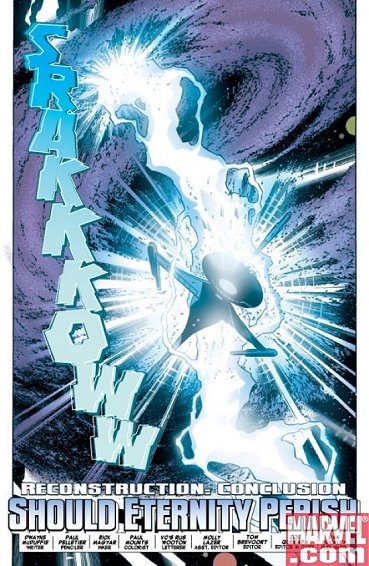
In Mark Millar's 16 issues we see the Fantastic Four at their worst, Completely out of character, with nothing making sense:
Clearly these are alternate reality versions of the team: parallel dimensions are merging, ready for the Chaos War. The alternative reality (for so he must be) Master of Doom has been traveling through alternate realities, killing whole universes (and parallel Fantastic Four teams).This is just what Franklin, as guardian of the sacred time lines, was supposed to stop. As the blogger Caleb summarizes: "It all comes down to our FF and a few allies trying to hold off armies of infinite, alternate universe versions of themselves while also dealing with a guy who seems like the biggest Big Bad they’ve ever battled."And the final battle is a big car crash of alternate realities - note the dinosaur Captain America!
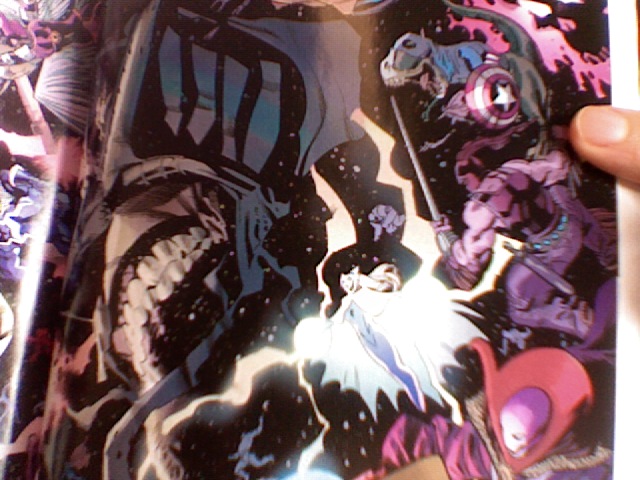
Once again the team defeats the immediate temporary threat, but the cross-dimensional carnage expands and reaches its climax into Hickman's run.
In the pantheon of fan horrors the only crime worse than Reed
following bratty Valeria was Doom following anybody. This took
place in the Mark Millar "master of Doom" arc. In it, Doom's never
before heard of master appears and Doom kneels. This is
unthinkable for normal Doom, but his recent activity shows he has
become unhinged. He realizes he has failed, but can barely admit
it to himself. In Mark Waid's run Doom admitted failure and tried
to renounce science. He ended up in Hell. He then lost his mind.
He is, in fact, repeating Reed's breakdown from Act 4.
As for Doom following nobody, the irony is that magic involves
precisely that: following higher powers. Doom of course sees it as
using them, but they
will see it differently. Higher powers are all linked: the
abstract concept of destruction, seen by Doom as a death like
master, is of course the concept seen by others as Galactus. See the cosmic page for details.
But Doom's view of destruction is far more personal, loving power
for its own sake whereas Galactus is neutral.
Note that the Master of Doom arc is the last chaotic moment
before the Great Reboot begins. At this moment of colliding
dimensions and falling apart it is impossible to separate reality
from illusion The masters of Doom routinely used illusion, and
nobody seriously believes that Doom really survived a million
years on hate alone, then gained powers he never used again It's a
swirling soup of chaos: see below. The cosmic page notes that
nothing a destructive higher power does can be taken on face
value. Note also that Galactus is the servant of Franklin, in the
sense that destruction is a servant of desire. This is all part of
a bigger story, though since the end of Act 5 and the decent into
the Franklinverse that bigger story is never obvious on the
surface.
The Marquis of death
The master of Doom and his sidekick are two versions Clyde
Wyncham, best known for the "1985" series. That was about a real
world comic reader who brings in fictional villains to his world
and almost destroys it. IT symbolizes the triumph of escapism, the
retreat from reality that took place as Jim Shooter was pushed out
in the mid 1980s.
"During the fight [with Doom], the Marquis and his apprentice created an illusion in which Doom, allied with nearly every hero and villain on Earth, managed to defeat them by imprisoning them in the "Omega Box". For the next five years following their imprisonment, Doom led the world into a new golden age and was married to the Invisible Woman, with whom he was expecting a child. When Sue asked him if he was finally happy, Doom responded that he had never been happier. It was then that "Sue" revealed herself to be the apprentice. The Marquis then stepped out of the Omega Box and revealed to Doom that less than five seconds had actually passed. The Marquis then explained to Doom that by showing him the "perfect life" would make his defeat much more painful. The Marquis then sent out a massive blast of energy, wiping out Latveria's entire capital city and the rest of the country. The Marquis then turned Doom's heart into stone and his blood into acid and had his apprentice to open a time-rift into the Pliocene Age, where he tossed the dying Doom into a primordial ocean, where he appeared to have been consumed by a Megalodon. [...] It was then that his apprentice revealed himself to be Victor Von Doom, having survived his apparent death because of his intense hatred and spent the last several million years mastering the Black Arts as well as many other God-like abilities, transforming his body until not even a molecule remained that could betray his identity to the Marquis when he became his apprentice in preparation for the day when he could finally get revenge on him. Upon learning who his "new" apprentice actually was, the Marquis begged for Doom to spare him but Doom told him to be silent and then swiftly ended his life."
When asked about "million year old Doom," editor Tom Brevoort (on
his Formspring account) simply noted that Doom tells lies.
Clearly this is largely illusion and chaos, but it reflects a
reality: Doom will indeed finally achieve happiness by merging
with the family, where Reed (as Doom) is married to Sue, the
Baroness, and raises Valeria in Otherplace. Is this creepy, Doom
being somehow inside Reed? No, because Doom's deepest wish has
always been power. As we see in
the cosmic page, when on becomes powerful enough, one
becomes merged with the infinite, almost an abstract concept. By
embracing the light Doom will finally get what he wants, absolute
power, a perfect world, and even union with the family of Sue.
Doom as the Marquis, yearning for Sue, is also symbolic. Ultimate power to destroy means becoming a reflection of Galactus. The futility of this win-lose approach to life is represented by Sue, who has always taught win-win. It was the Sue lookalike, Alicia, who first defeated Galactus, by inspiring the surfer to better things.
In the final analysis, Mark Millar's final arc was a sea of chaos and colliding realities, but it represented an underlying truth. For twenty years the Franklinverse had been falling apart, and finally it disintegrated completely. It was 2009, time to prepare for The Great Reboot.
Jonathan Hickman's run began with FF570. Reed Richards decides to "solve everything." Next we'll see how everything is solved.
